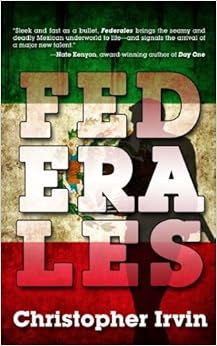Guest Post by Chris Irvin
The very first scene I wrote for Federales in late 2012 was to be exactly that – the opening scene of the book. In medias res, I thought, you got this. Sparing you spoilers, the scene sets the tone, gives off a specific (read: dark) vibe. How’d we arrive there? That’s to be the job of backstory and flashbacks. All will be covered and explained in due time. I’m in the action where I need to be. Then I stumbled upon Benjamin Percy’s (author of Red Moon) essay, “Don’t look back: The Problem with Backstory,” in Poets & Writers.
The essay argues against the overuse of backstory, especially by beginning writers, and immediately clicked with me. If I had something closely resembling V, why not begin with A as opposed to cramming it and the rest of the alphabet into the span of a few scenes? I went back to the drawing board. Did I still have backstory in the end? Sure, but it wasn’t the back and forth mess I set out to originally create.*
But what writing that ‘first’ scene did for me was pin down the approximate end and help me outline the rest of the story. Gave me a path for where I needed to go. Was it hard? Oh yeah. I’m a plotter by necessity, but a rough plotter and I usually leave the end a bit vague to keep myself interested. If I’ve already written the book/story/etc. in my head, it’s difficult for me to duplicate on paper. So much so that the first draft of Federales I gave to my writing group consisted of the beginning and the end, with an explanation to something of the effect, “stuff happens in the middle. I’ll make it work.” It was a grind. But I learned a lot about my writing process along the way.
I began my current WIP novel in a similar way – found where I wanted to go and asked the question, how do I get there? Well, “there” changed as the first 1/3 of the novel took form, but it still gave me a point to aim for.
Every writer’s process is different, but maybe give ‘beginning with the end’ a shot. It could be the scene(s) that transforms and feeds the rest of the work.
*For those interested in the merits of backstory, check out Eleanor Henderson’s rebuttal of Percy’s essay, “I Wasn’t Born Yesterday: The Beauty of Backstory.”
Christopher Irvin has traded all hope of a good night’s rest for the chance to spend his mornings writing dark and noir fiction. His short stories have appeared in several publications, including Thuglit, Beat to a Pulp, and Shotgun Honey. His debut novella, FEDERALES, is due out in March 2014 from One Eye Press. He lives with his wife and son in Boston, Massachusetts. For more, visit christopherirvin.net.


In medias res is how my brain works. I love setting up an opening scene which is really the last few seconds of the story and then going back. I don't do it all the time but it immediately grabs the reader and yanks them along with you. What's the test of a novel? If a potential reader picks it up in the store, checks the first few paragraphs and then HAS to buy it because they're hooked. In medias res is a great technique for this when used properly.
ReplyDeleteI read both articles. Henderson's is far more compelling than Percy's, She nails it when she says he seems to confuse backstory with flashbacks; they're not at all the same thing.
ReplyDeleteI'm someone who doesn't use a lot of backstory, but characters' actions need context. You work it in elegantly as you can. Which he says, far down the article, in a manner that makes the article seem to wander.
His last paragraph seals the deal for me: his self-confessed tendency to make pronouncements. Do this. Never do that. Not only is he too full of himself for me to take seriously, he's guilty of the writing teacher's most serious crime: insisting his students write as he does.
Great points, Dana. I think you're right on the money.
ReplyDelete